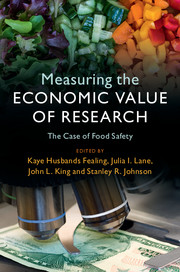Book contents
- Measuring the Economic Value of Research
- Measuring the Economic Value of Research
- Copyright page
- Dedication
- Contents
- Figures
- Tables
- Contributors
- Foreword
- Acknowledgments
- 1 Introduction and Motivation
- 2 The Current Context
- 3 The Conceptual and Empirical Framework
- 4 Identifying Food Safety–Related Research
- 5 The Structure of Research Funding
- 6 The Food Safety Research Workforce and Economic Outcomes
- 7 New Insights into Food Safety Research Teams
- 8 Assessing the Effects of Food Safety Research on Early Career Outcomes
- 9 Describing Patent Activity
- 10 Describing Scientific Outcomes
- 11 Conclusion
- Index
- References
7 - New Insights into Food Safety Research Teams
Published online by Cambridge University Press: 15 December 2017
- Measuring the Economic Value of Research
- Measuring the Economic Value of Research
- Copyright page
- Dedication
- Contents
- Figures
- Tables
- Contributors
- Foreword
- Acknowledgments
- 1 Introduction and Motivation
- 2 The Current Context
- 3 The Conceptual and Empirical Framework
- 4 Identifying Food Safety–Related Research
- 5 The Structure of Research Funding
- 6 The Food Safety Research Workforce and Economic Outcomes
- 7 New Insights into Food Safety Research Teams
- 8 Assessing the Effects of Food Safety Research on Early Career Outcomes
- 9 Describing Patent Activity
- 10 Describing Scientific Outcomes
- 11 Conclusion
- Index
- References
Summary

- Type
- Chapter
- Information
- Measuring the Economic Value of ResearchThe Case of Food Safety, pp. 113 - 127Publisher: Cambridge University PressPrint publication year: 2017



